HYUNDAI I800 2016 User Guide
Manufacturer: HYUNDAI, Model Year: 2016, Model line: I800, Model: HYUNDAI I800 2016Pages: 419, PDF Size: 9.23 MB
Page 11 of 419
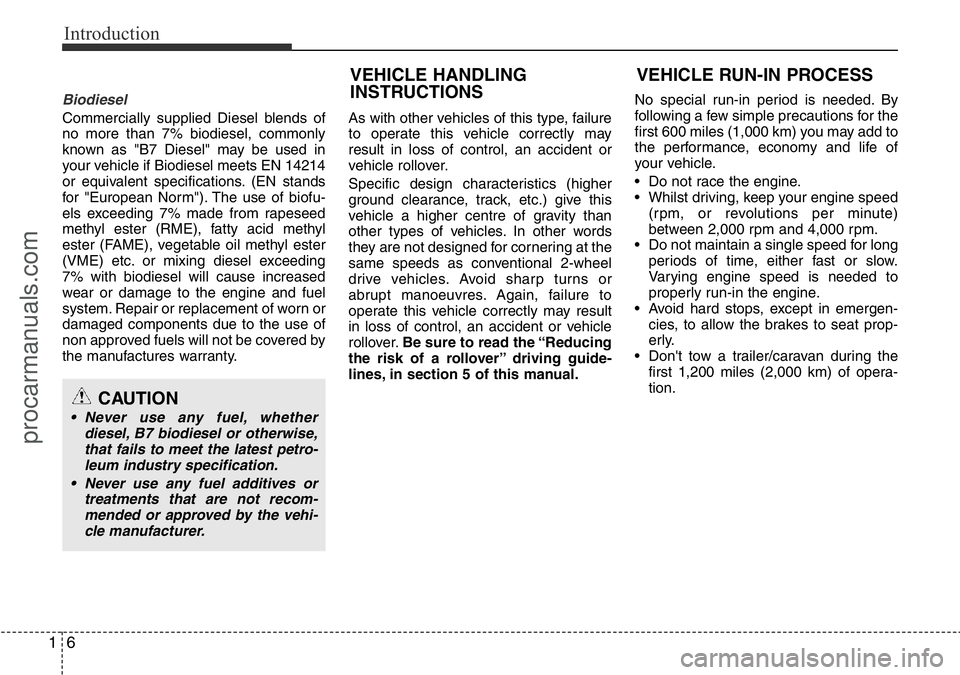
Introduction
6 1
Biodiesel
Commercially supplied Diesel blends of
no more than 7% biodiesel, commonly
known as "B7 Diesel" may be used in
your vehicle if Biodiesel meets EN 14214
or equivalent specifications. (EN stands
for "European Norm"). The use of biofu-
els exceeding 7% made from rapeseed
methyl ester (RME), fatty acid methyl
ester (FAME), vegetable oil methyl ester
(VME) etc. or mixing diesel exceeding
7% with biodiesel will cause increased
wear or damage to the engine and fuel
system. Repair or replacement of worn or
damaged components due to the use of
non approved fuels will not be covered by
the manufactures warranty.As with other vehicles of this type, failure
to operate this vehicle correctly may
result in loss of control, an accident or
vehicle rollover.
Specific design characteristics (higher
ground clearance, track, etc.) give this
vehicle a higher centre of gravity than
other types of vehicles. In other words
they are not designed for cornering at the
same speeds as conventional 2-wheel
drive vehicles. Avoid sharp turns or
abrupt manoeuvres. Again, failure to
operate this vehicle correctly may result
in loss of control, an accident or vehicle
rollover.Be sure to read the “Reducing
the risk of a rollover” driving guide-
lines, in section 5 of this manual.No special run-in period is needed. By
following a few simple precautions for the
first 600 miles (1,000 km) you may add to
the performance, economy and life of
your vehicle.
• Do not race the engine.
• Whilst driving, keep your engine speed
(rpm, or revolutions per minute)
between 2,000 rpm and 4,000 rpm.
• Do not maintain a single speed for long
periods of time, either fast or slow.
Varying engine speed is needed to
properly run-in the engine.
• Avoid hard stops, except in emergen-
cies, to allow the brakes to seat prop-
erly.
• Don't tow a trailer/caravan during the
first 1,200 miles (2,000 km) of opera-
tion.
VEHICLE RUN-IN PROCESS VEHICLE HANDLING
INSTRUCTIONS
CAUTION
• Never use any fuel, whether
diesel, B7 biodiesel or otherwise,
that fails to meet the latest petro-
leum industry specification.
• Never use any fuel additives or
treatments that are not recom-
mended or approved by the vehi-
cle manufacturer.
procarmanuals.com
Page 12 of 419

2
Interior overview / 2-2
Instrument panel overview / 2-3
Engine compartment / 2-4
Your vehicle at a glance
procarmanuals.com
Page 13 of 419
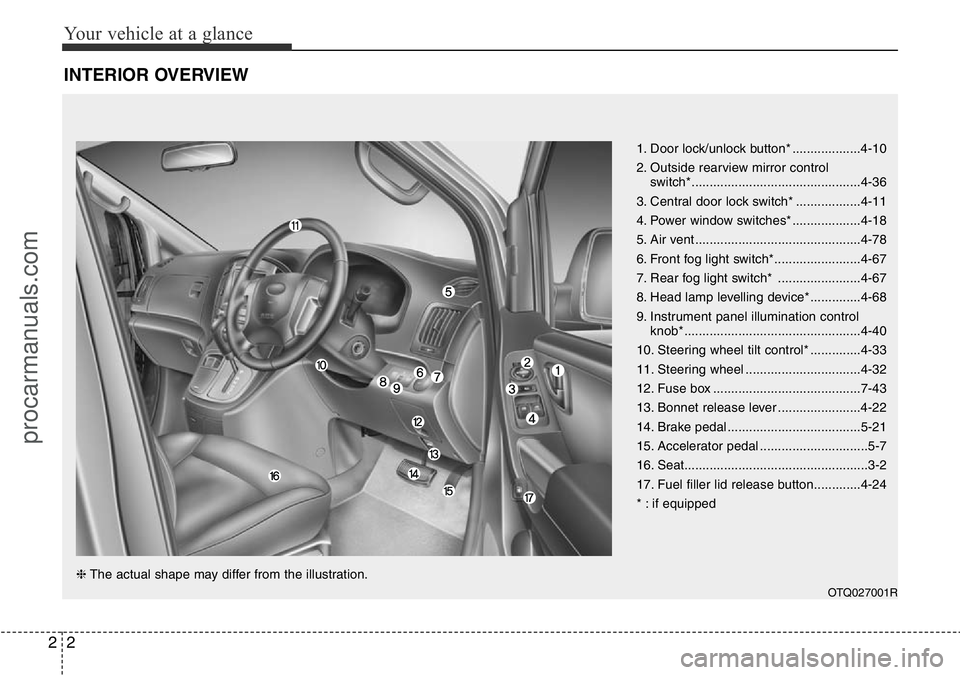
Your vehicle at a glance
2 2
INTERIOR OVERVIEW
1. Door lock/unlock button* ...................4-10
2. Outside rearview mirror control
switch*...............................................4-36
3. Central door lock switch* ..................4-11
4. Power window switches* ...................4-18
5. Air vent ..............................................4-78
6. Front fog light switch*........................4-67
7. Rear fog light switch* .......................4-67
8. Head lamp levelling device* ..............4-68
9. Instrument panel illumination control
knob* .................................................4-40
10. Steering wheel tilt control* ..............4-33
11. Steering wheel ................................4-32
12. Fuse box .........................................7-43
13. Bonnet release lever .......................4-22
14. Brake pedal .....................................5-21
15. Accelerator pedal ..............................5-7
16. Seat...................................................3-2
17. Fuel filler lid release button.............4-24
* : if equipped
OTQ027001R
❈The actual shape may differ from the illustration.
procarmanuals.com
Page 14 of 419
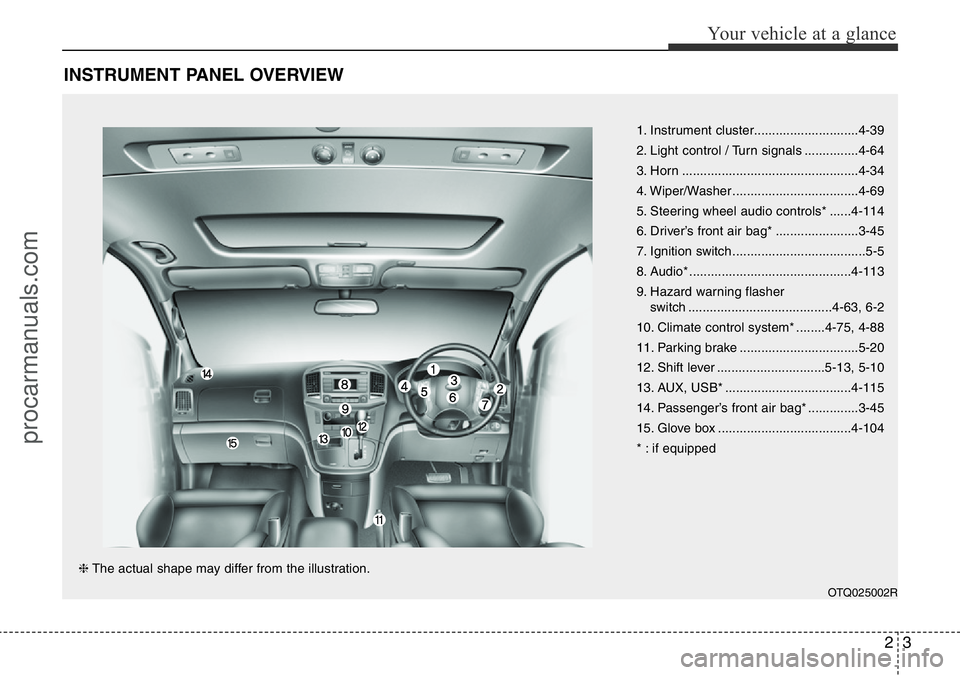
23
Your vehicle at a glance
INSTRUMENT PANEL OVERVIEW
1. Instrument cluster.............................4-39
2. Light control / Turn signals ...............4-64
3. Horn .................................................4-34
4. Wiper/Washer ...................................4-69
5. Steering wheel audio controls* ......4-114
6. Driver’s front air bag* .......................3-45
7. Ignition switch .....................................5-5
8. Audio* .............................................4-113
9. Hazard warning flasher
switch ........................................4-63, 6-2
10. Climate control system* ........4-75, 4-88
11. Parking brake .................................5-20
12. Shift lever ..............................5-13, 5-10
13. AUX, USB* ...................................4-115
14. Passenger’s front air bag* ..............3-45
15. Glove box .....................................4-104
* : if equipped
OTQ025002R
❈The actual shape may differ from the illustration.
procarmanuals.com
Page 15 of 419
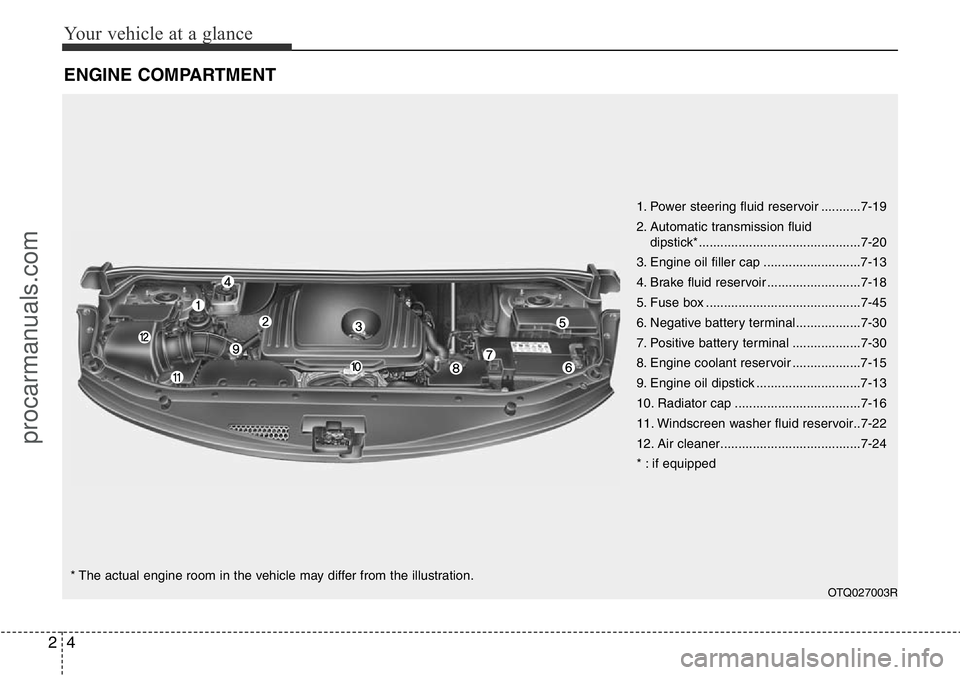
Your vehicle at a glance
4 2
ENGINE COMPARTMENT
1. Power steering fluid reservoir ...........7-19
2. Automatic transmission fluid
dipstick*.............................................7-20
3. Engine oil filler cap ...........................7-13
4. Brake fluid reservoir ..........................7-18
5. Fuse box ...........................................7-45
6. Negative battery terminal..................7-30
7. Positive battery terminal ...................7-30
8. Engine coolant reservoir ...................7-15
9. Engine oil dipstick .............................7-13
10. Radiator cap ...................................7-16
11. Windscreen washer fluid reservoir..7-22
12. Air cleaner.......................................7-24
* : if equipped
OTQ027003R
* The actual engine room in the vehicle may differ from the illustration.
procarmanuals.com
Page 16 of 419
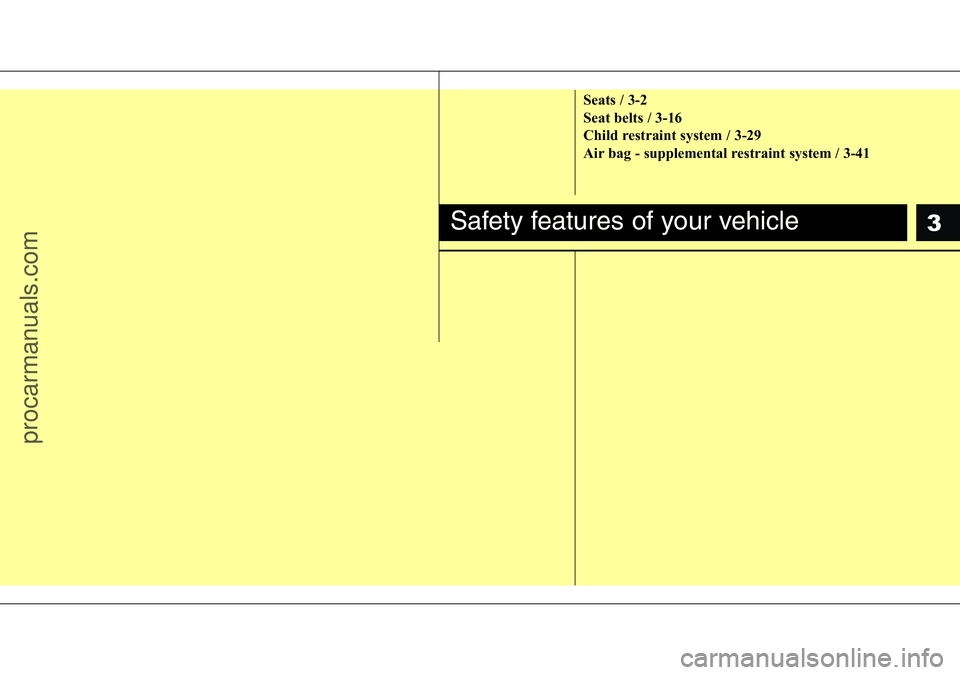
3
Seats / 3-2
Seat belts / 3-16
Child restraint system / 3-29
Air bag - supplemental restraint system / 3-41
Safety features of your vehicle
procarmanuals.com
Page 17 of 419
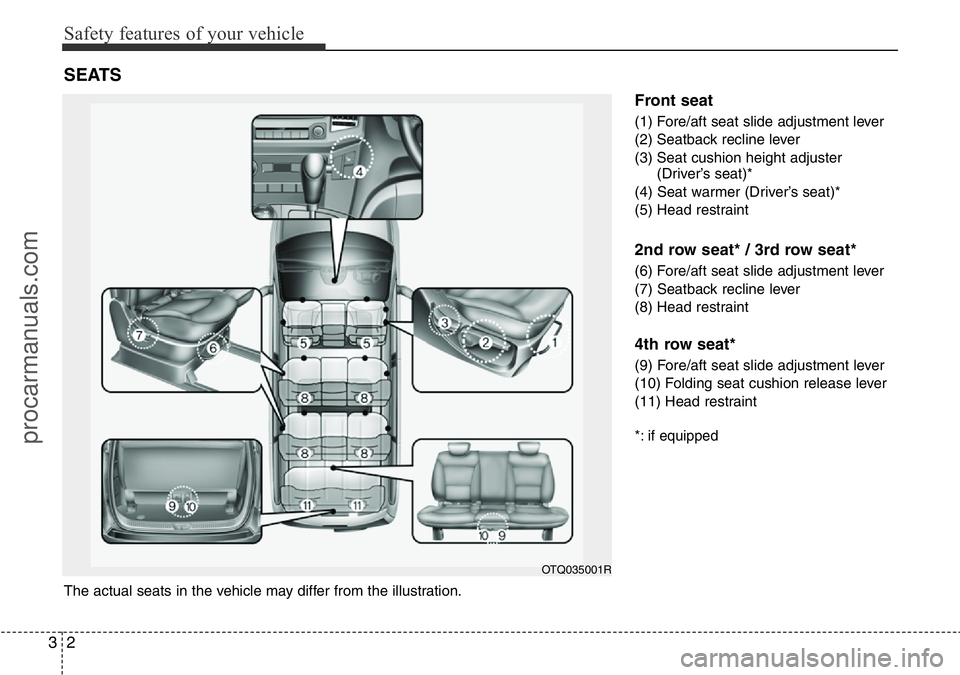
Safety features of your vehicle
2 3
Front seat
(1) Fore/aft seat slide adjustment lever
(2) Seatback recline lever
(3) Seat cushion height adjuster
(Driver’s seat)*
(4) Seat warmer (Driver’s seat)*
(5) Head restraint
2nd row seat* / 3rd row seat*
(6) Fore/aft seat slide adjustment lever
(7) Seatback recline lever
(8) Head restraint
4th row seat*
(9) Fore/aft seat slide adjustment lever
(10) Folding seat cushion release lever
(11) Head restraint
*: if equipped
SEATS
OTQ035001R
The actual seats in the vehicle may differ from the illustration.
procarmanuals.com
Page 18 of 419
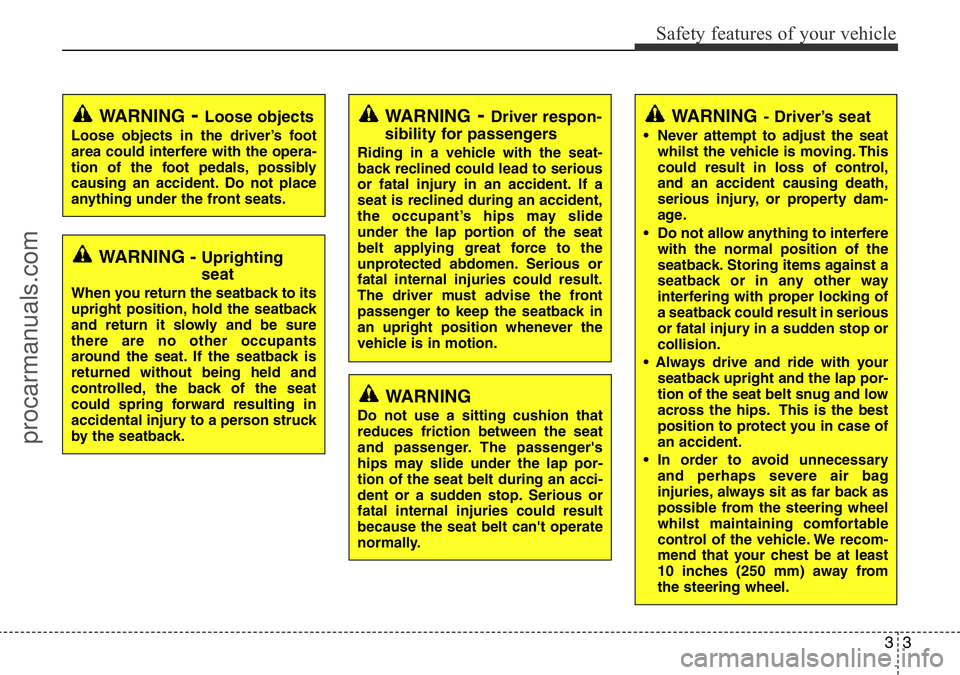
33
Safety features of your vehicle
WARNING- Driver’s seat
• Never attempt to adjust the seat
whilst the vehicle is moving. This
could result in loss of control,
and an accident causing death,
serious injury, or property dam-
age.
• Do not allow anything to interfere
with the normal position of the
seatback. Storing items against a
seatback or in any other way
interfering with proper locking of
a seatback could result in serious
or fatal injury in a sudden stop or
collision.
• Always drive and ride with your
seatback upright and the lap por-
tion of the seat belt snug and low
across the hips. This is the best
position to protect you in case of
an accident.
• In order to avoid unnecessary
and perhaps severe air bag
injuries, always sit as far back as
possible from the steering wheel
whilst maintaining comfortable
control of the vehicle. We recom-
mend that your chest be at least
10 inches (250 mm) away from
the steering wheel.
WARNING - Uprighting
seat
When you return the seatback to its
upright position, hold the seatback
and return it slowly and be sure
there are no other occupants
around the seat. If the seatback is
returned without being held and
controlled, the back of the seat
could spring forward resulting in
accidental injury to a person struck
by the seatback.
WARNING- Loose objects
Loose objects in the driver’s foot
area could interfere with the opera-
tion of the foot pedals, possibly
causing an accident. Do not place
anything under the front seats.
WARNING- Driver respon-
sibility for passengers
Riding in a vehicle with the seat-
back reclined could lead to serious
or fatal injury in an accident. If a
seat is reclined during an accident,
the occupant’s hips may slide
under the lap portion of the seat
belt applying great force to the
unprotected abdomen. Serious or
fatal internal injuries could result.
The driver must advise the front
passenger to keep the seatback in
an upright position whenever the
vehicle is in motion.
WARNING
Do not use a sitting cushion that
reduces friction between the seat
and passenger. The passenger's
hips may slide under the lap por-
tion of the seat belt during an acci-
dent or a sudden stop. Serious or
fatal internal injuries could result
because the seat belt can't operate
normally.
procarmanuals.com
Page 19 of 419
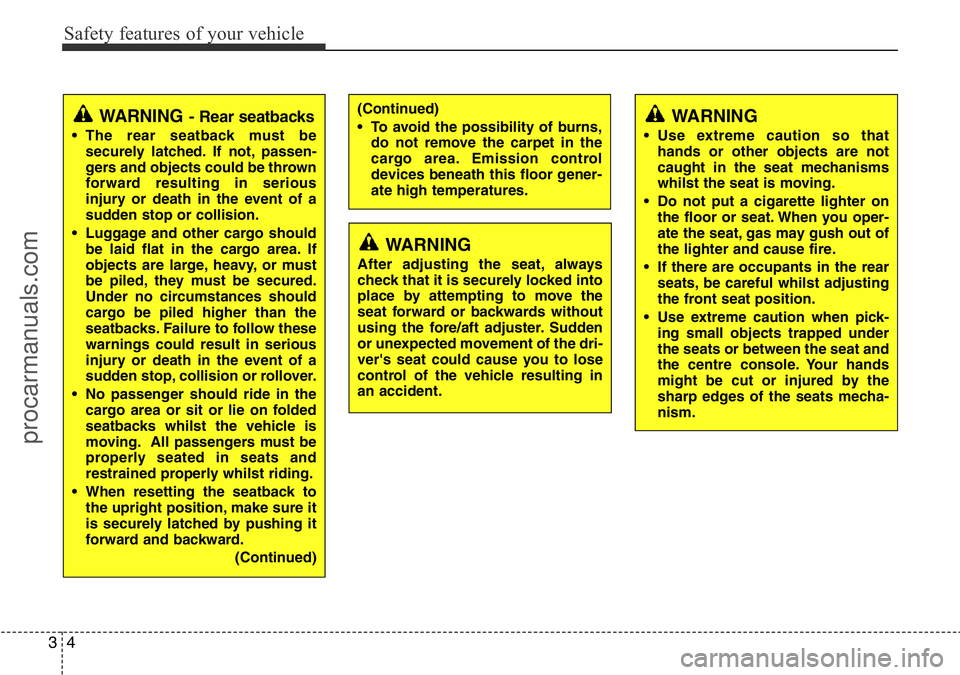
Safety features of your vehicle
4 3
(Continued)
• To avoid the possibility of burns,
do not remove the carpet in the
cargo area. Emission control
devices beneath this floor gener-
ate high temperatures.WARNING- Rear seatbacks
• The rear seatback must be
securely latched. If not, passen-
gers and objects could be thrown
forward resulting in serious
injury or death in the event of a
sudden stop or collision.
• Luggage and other cargo should
be laid flat in the cargo area. If
objects are large, heavy, or must
be piled, they must be secured.
Under no circumstances should
cargo be piled higher than the
seatbacks. Failure to follow these
warnings could result in serious
injury or death in the event of a
sudden stop, collision or rollover.
• No passenger should ride in the
cargo area or sit or lie on folded
seatbacks whilst the vehicle is
moving. All passengers must be
properly seated in seats and
restrained properly whilst riding.
• When resetting the seatback to
the upright position, make sure it
is securely latched by pushing it
forward and backward.
(Continued)
WARNING
After adjusting the seat, always
check that it is securely locked into
place by attempting to move the
seat forward or backwards without
using the fore/aft adjuster. Sudden
or unexpected movement of the dri-
ver's seat could cause you to lose
control of the vehicle resulting in
an accident.
WARNING
• Use extreme caution so that
hands or other objects are not
caught in the seat mechanisms
whilst the seat is moving.
• Do not put a cigarette lighter on
the floor or seat. When you oper-
ate the seat, gas may gush out of
the lighter and cause fire.
• If there are occupants in the rear
seats, be careful whilst adjusting
the front seat position.
• Use extreme caution when pick-
ing small objects trapped under
the seats or between the seat and
the centre console. Your hands
might be cut or injured by the
sharp edges of the seats mecha-
nism.
procarmanuals.com
Page 20 of 419
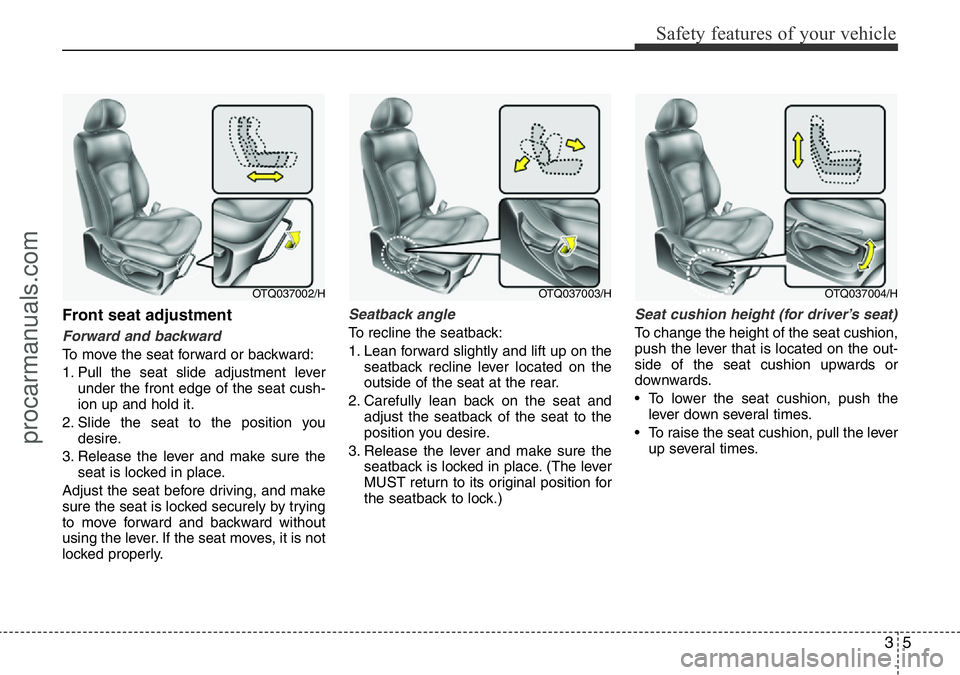
35
Safety features of your vehicle
Front seat adjustment
Forward and backward
To move the seat forward or backward:
1. Pull the seat slide adjustment lever
under the front edge of the seat cush-
ion up and hold it.
2. Slide the seat to the position you
desire.
3. Release the lever and make sure the
seat is locked in place.
Adjust the seat before driving, and make
sure the seat is locked securely by trying
to move forward and backward without
using the lever. If the seat moves, it is not
locked properly.
Seatback angle
To recline the seatback:
1. Lean forward slightly and lift up on the
seatback recline lever located on the
outside of the seat at the rear.
2. Carefully lean back on the seat and
adjust the seatback of the seat to the
position you desire.
3. Release the lever and make sure the
seatback is locked in place. (The lever
MUST return to its original position for
the seatback to lock.)
Seat cushion height (for driver’s seat)
To change the height of the seat cushion,
push the lever that is located on the out-
side of the seat cushion upwards or
downwards.
• To lower the seat cushion, push the
lever down several times.
• To raise the seat cushion, pull the lever
up several times.
OTQ037002/HOTQ037004/HOTQ037003/H
procarmanuals.com